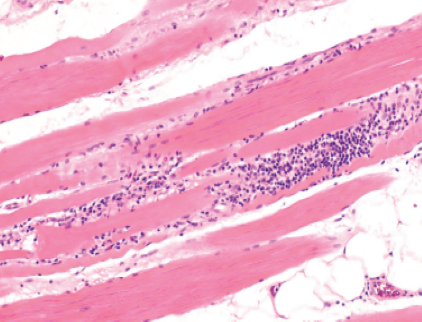Recent research suggests JAK inhibitors, specifically tofacitinib, may be useful in the management of refractory dermatomyositis.
With Ted Rosen, MD, FAAD

In 2016, dermatologists from Harvard Medical School published what they described as the first report of the successful use of the Janus kinase (JAK)-1/3 inhibitor, tofacitinib, to treat refractory cutaneous dermatomyositis (DM).1 Based on evidence suggesting that tofacitinib suppresses the interferon signaling pathway that is implicated in the pathophysiology of this rare idiopathic multisystem autoinflammatory disease, the investigators identified three patients with refractory DM, treated them with tofacitinib, and found all three patients achieved a clinically significant response as defined by the magnitude of improvement in their Cutaneous Dermatomyositis Disease Area and Severity Index (CDASI) score.
In a research letter published in the Journal of the American Academy of Dermatology in February 2022, the Harvard dermatologists reported their expanded experience with successful use of tofacitinib to treat refractory cutaneous DM.2 Searching through a clinical data registry that captures patients cared for at two Harvard-affiliated hospitals, they identified 11 patients who had been diagnosed with DM, prescribed a JAK inhibitor, and had baseline and follow-up CDASI data. All of the patients received tofacitinib, and they all achieved clinically meaningful improvement as defined by change in CDASI score. In addition, all patients benefited with significant improvement in self-reported pruritus severity, and myositis resolved in the two patients who had active muscle disease.
No patients had to stop treatment because of an adverse event. During a mean treatment duration of 27.2 months, orolabial herpes simplex virus infection in a single patient was the only reported adverse event.
The investigators concluded that tofacitinib is a well-tolerated systemic treatment choice for refractory cutaneous DM, and they encouraged further investigation to help validate their findings.
Digging Into the Details
The 11 patients in the retrospective review comprised 10 women and one man. All of the patients were white, and they ranged in age from 19 to 74 years. Amyopathic DM was the most common subtype (n = 5); classic DM with active myositis, classic postmyopathic DM, and juvenile postmyopathic DM were equally represented among the remaining six patients.
The number of previous systemic therapies ranged from four to nine and included hydroxychloroquine, prednisone, methotrexate, mycophenolate, intravenous immunoglobulin G, lenalidomide, isotretinoin, dapsone, azathioprine, rituximab, thalidomide, quinacrine, cyclosporine, quinacrine, infliximab, and subcutaneous immunoglobulin.
Tofacitinib was administered at dose of 5 mg or 10 mg twice a day or 11 mg extended release twice a day. Only one patient was maintained on 5 mg twice daily, while others who were started on that regimen required a dose increase. The researchers pointed out that 10 of the 11 patients required a dose of tofacitinib higher than that typically used for treating rheumatoid arthritis or psoriatic arthritis (the recommended dose for the latter two diseases is 5 mg twice a day or 11 mg extended release once a day). The JAK inhibitor was used as monotherapy in three patients and with up to three additional therapies in the remaining patients.
Mean CDASI for the group was 27.7 (range, 17 to 38) at baseline, and it improved by a mean of 17.8. All patients achieved at least an 11-point improvement in CDASI score (a change of 4 to 5 points is considered clinically meaningful). The mean improvement in CDASI score across the different DM subtypes ranged from 16.75 to 19.
Eight patients experienced clinically significant improvement within one month after starting tofacitinib, two benefited within 1.5 months, and the remaining patient improved by month two.
The patients in the series had been on tofacitinib for a duration of 11 to 40 months, and during that time, all but one patient was able to discontinue or taper concomitant therapies.
Accumulating Experience
Since the Harvard researchers reported their initial series, there have been several other published articles describing patients treated with tofacitinib or ruxolitinib for refractory DM. These additional reports include a recent systematic literature review of 14 studies encompassing 54 patients treated with tofacitinib or ruxolitinib and a 12-week prospective open-label clinical trial of tofacitinib conducted at Johns Hopkins University plus a follow-up report of outcomes from a long-term extension of the latter trial.3-5
The collective findings from this experience indicate that JAK inhibitors are a promising treatment for refractory DM with acceptable safety and durable efficacy. However, several questions remain to be answered. For example, is there a clinical advantage for using any one JAK inhibitor compared to other agents in this class of small-molecule drugs? Would there be even greater benefit from utilizing a JAK inhibitor earlier in the disease course as monotherapy or in conjunction with standard therapeutic interventions?
Some insight into these issues may come from a multicenter study that will be underway in France. Known as BIRD, it is a 24-week, quadruple-masked, placebo-controlled study investigating treatment with the JAK-1/2 inhibitor, baricitinib, in patients with relapsing or naïve DM.6
This prospective trial has a planned enrollment of 62 patients. Patients in both the baricitinib and placebo arms will also receive prednisone with tapering according to a predefined protocol plus one immunosuppressive drug (either methotrexate or azathioprine). The primary endpoint is evaluating prednisone-free moderate improvement at week 24, defined as a total improvement score superior or equal to 40 following ACR/EULAR definition without the need for prednisone.
The study has an anticipated start date of May 2022, but its estimated completion date is not until December 2025.
By Cheryl Guttman Krader
References
1. Kurtzman DJ, Wright NA, Lin J, et al. Tofacitinib Citrate for Refractory Cutaneous Dermatomyositis: An Alternative Treatment. JAMA Dermatol. 2016;152(8):944-945. doi:10.1001/jamadermatol.2016.0866.
2. Min MS, Alsarheed A, Kassamali B, et al. Tofacitinib as treatment for refractory dermatomyositis: A retrospective study from 2 academic medical centers. J Am Acad Dermatol. 2022;86(2):423-425. doi:10.1016/j.jaad.2021.07.003.
3. Paudyal A, Zheng M, Lyu L, et al. JAK-inhibitors for dermatomyositis: A concise literature review. Dermatol Ther. 2021;34(3):e14939. doi:10.1111/dth.14939
4. Paik JJ, Casciola-Rosen L, Shin JY, et al. Study of Tofacitinib in Refractory Dermatomyositis: An Open-Label Pilot Study of Ten Patients. Arthritis Rheumatol. 2021;73(5):858-865. doi:10.1002/art.41602.
5. Paik JJ, Shneyderman M, Gutierrez-Alamillo L, et al. Long-term extension study of tofacitinib in refractory dermatomyositis. Arthritis Rheumatol. 2022;74(2):371-372. doi:10.1002/art.41944.
6. Baricitinib in Patients With Relapsing or naïve Dermatomyositis (BIRD)
https://clinicaltrials.gov/ct2/show/NCT04972760?cond=dermatomyositis&draw=2&rank=1. Accessed March 22, 2022.


